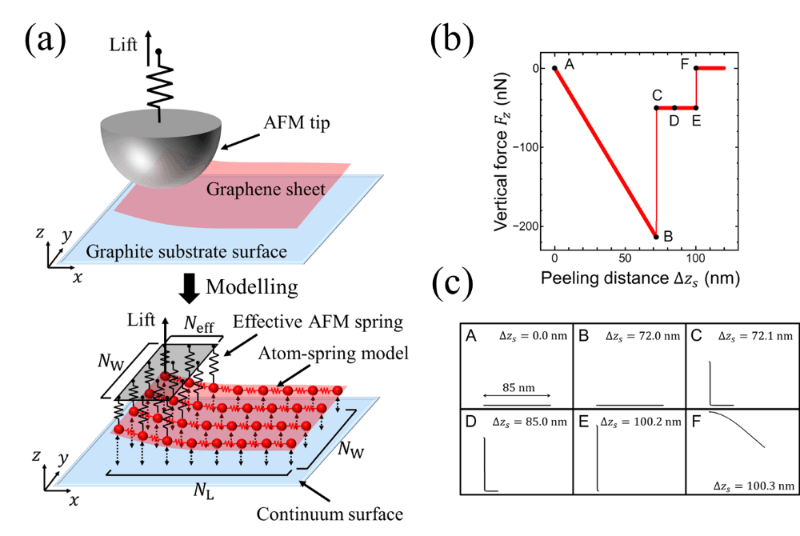Sep 13 2019
Control of atomic-scale friction and adhesion is critical for effective manipulation of the motion of nano- or micro-meter scale objects at interfaces. For example, in nanotechnology controlling adhesion during the peeling process of graphene sheets plays a very important role in manipulation and fabrication.
 (a) Schematic illustration of the peeling experiment (upper) and the peeling simulation by using a time-saving potential model. (b) The vertical force acting on the support position, plotted as a function of the peeling edge during the peeling process. Characteristic step structure appears between B and C, and E and F. (c) Transition of the shape of the armchair graphene sheet (85*196 nm2) during the peeling process from A to F.
(a) Schematic illustration of the peeling experiment (upper) and the peeling simulation by using a time-saving potential model. (b) The vertical force acting on the support position, plotted as a function of the peeling edge during the peeling process. Characteristic step structure appears between B and C, and E and F. (c) Transition of the shape of the armchair graphene sheet (85*196 nm2) during the peeling process from A to F.
Graphene is a promising material due to its mechanical, electronic, magnetic, spintronic, and optical properties. In previous work, a comparison between simulation and experiment of peeling graphene has revealed its unique frictional and adhesive properties.
However, computation time becomes longer as the size of graphene increases, so a direct comparison of the simulated vertical force curve with experiments is difficult. Furthermore, it is also difficult to separate pure effects related to adhesion from those due to friction during the peeling process.
Here, Ryoji Okamoto, Koki Yamasaki, and Naruo Sasaki at The University of Electro-Communications have developed a time-saving potential model to simulate the adhesive characteristics during the peeling process of armchair-type graphene sheets from frictionless graphite substrate surfaces.
Using its structural symmetry, the armchair-type graphene sheet was reduced to the effective spring model [Fig. (a)]. Then the edge of the spring model was lifted along the vertical direction. For each lifting position, the model was structurally optimized using the conjugate gradient method.
The main results were: (1) The computation time by this potential was reduced to 1/6400 compared to our previous model. (2) The transition of the shape of the graphene sheet and the vertical force curve obtained by this model successfully reproduced those obtained by our previous model. (3) This potential model was successfully extended to include the effective stiffness of an atomic force microscopy (AFM), which consists of the stiffness of the cantilever, tip and contact region [Fig. (a)]. The characteristic step structure of the vertical force curve was obtained by the extended model [Figs. (b) and (c)].
Our approach opens new directions for multiscale physics of the peeling process of the elastic sheet from atomic to micrometer-scale, and interpretation of force-spectroscopy observed by AFM.
References
- Authors: Ryoji Okamoto, Koki Yamasaki and Naruo Sasaki.
- Title of original paper: New potential model for atomic-scale peeling of armchair graphene: toward understanding of micrometer-scale peeling.
- Journal, volume, pages and year: Materials Chemistry Frontiers 2, 2098-2103 (2018).
- Digital Object Identifier (DOI): 10.1039/c8qm00267c
- Affiliations: Department of Engineering Science, The University of Electro-Communications.
- Sasaki Lab. website: http://nanotribo.g-edu.uec.ac.jp/